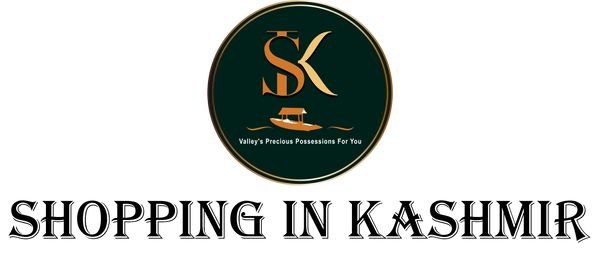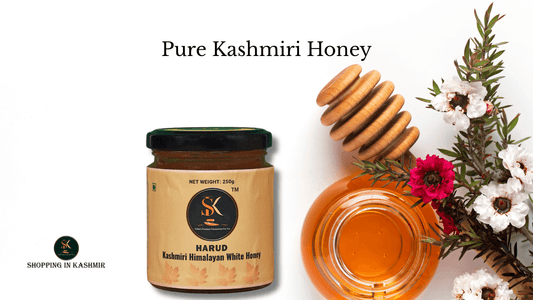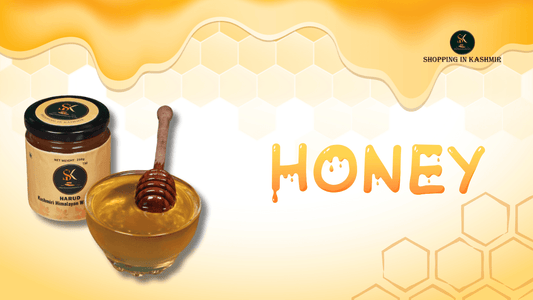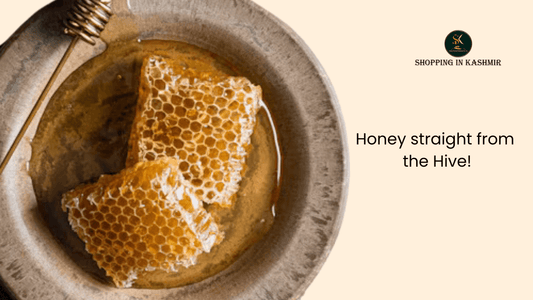
Saffron: All you need to know about the Golden Spice of Kashmir
Share
Saffron, Kesar, Zafran, or Kong as called in Kashmiri, is known as the “golden spice” of Kashmir. Known for its rich colour and flavour, saffron is one of the costliest spices of the world with Kashmiri Saffron being the finest and highly demanded. The exceptional soil conditions and unique climate of Kashmir, induces it with a distinct flavour and aroma. Saffron is derived from the stigmas of the Crocus sativus flower, commonly known as Saffron crocus. Upon extractions, the crimson coloured stigma and style of this flower are collected and dried immediately, and preferably sealed in airtight containers. Kashmiri Saffron is 100% organic as it is grown without the use of any chemical fertilisers. It is grown and cultivated exclusively in the plains of “Pampore town” of Pulwama district in Kashmir. Known for its
- “Deep Reddish-Brown Colour” due to the high presence of a compound called crocin,
- its “Intense Aroma” with floral hints, hints of honey and earthy undertones,
- its “Delicate Flavour” with a subtle sweetness and hint of clear bitterness,
Kashmiri saffron stands out in its kind!

Saffron Uses: a Versatile Treasure
Saffron is mainly used for “Culinary Purposes” like cooking and baking. It used to add flavour and aroma to various dishes like biryani, cakes and cookies. It is also used to add colour and flavour to rice particularly in Middle East regions.
Saffron is also used as a “Cultural and Traditional” asset. Be it wedding ceremonies or festivals, saffron is used as a symbol of good luck and prosperity.
Saffron has a significance in “Medicinal and Wellness” purposes. It helps with digestive problems, enhances mood, brightens and tones the skin, and is used in many cosmetic products.
Saffron has some other uses too, like “dying” the fabrics. It is a natural dye particularly for fabrics like silk and wool.
5 Medical Benefits of Saffron
Saffron is a true superfood offering a unique combination of nutrients that support your overall wellbeing. Here are its top 5 benefits-
1: Weight Management
The compounds present in Saffron are knows to boost metabolism and are found to posses anti-inflammatory properties, and hence help in “weight loss” and “weight management”.
2: Controlling Blood Sugar Levels
The amazing compounds present in saffron help in improving the body’a ability to utilise insulin effectively leading to better blood sugar control, keeping the levels normal.
3: Mood Enhancement
Saffron’s active compound “crocin”, is known for its antidepressant properties which releases serotonine and dopamine and hence uplifts your mood. It reduces negative emotions, promoting a positive mindset.
4: Glowing Skin
Saffron is rich in antioxidants thus clearing your skin off the mpurities from within and provides anti-aging properties. It also tones the skin and makes it glow naturally.
5: Menstrual relief
Saffrons helps in reducing the symptoms associated with PMS, such as bloating, cramps and mood swings, due to its anti-inflammatory and antioxidant effects.
Dive Into The Divine Process: from Cultivation to Harvesting:
The saffron crocus corms are planted in early summer around May - June. Saffron grows best in full sunlight and Pampore being a high altitude plain of Kashmir, becomes ideal for its cultivation. The fields are divided into narrow furrows (traditional raised beds) promoting good drainage and also help to reduce soil erosion. The bulb-like saffron corms and dug deep into the soil (7-15 cm), the corms planted deeper ensure yield higher quality saffron. After being nourished in soil through the summer, the corms begin to bud in early autumn. It is after the most flowering plants have grown and released their seeds, do these brilliantly flushed lilac to purple coloured flowers of saffron develop. The Kashmiri Saffron flower has a sweet honey-like fragrance. Each flower engulfs within, the vivid crimson coloured stigmas, which are then extracted to be used as the desired spice.
When the Harvest season arrives (from mid September to min November), it by necessity becomes a speedy affair and the flower quickly wilts as the day passes. The harvesting process requires labour intensive methods, in which saffron threads are manually extracted from the flowers. The strands are carefully hand picked from the saffron flower by the skilled labourers, to avoid damaging the delicate stigma. Around forty hours of labour are needed to pick 150,000 followers. The dried stigmas are graded according to their quality, colour and length. Roughly, around 150 flowers of Saffron yield 1 g of dry saffron threads. The yield of dried saffron threads from fresh saffron is only 13 g/kg. Besides this, ensuring high quality stigmas is crucial as it effects the final product’s flavour, aroma and colour.
Types of Saffron Available In The Market
Mainly there are two categories of Saffron found in Kashmiri market,
- Iranian Saffron
- Kashmiri Saffron
Both of these kinds are original Saffron, but if we talk about the quality, then Kashmiri Saffron surpasses it for sure. This can be understood by the fact that Kashmiri Saffron is used in less quantity to receive the same benefit as by the Iranian saffron, which is supposed to be used in more quantity for the same. Let’s say if we use 5 parts of Iranian saffron for some culinary purpose, to that only 3 parts of Kashmiri saffron will be enough comparatively.
Iranian Saffron can be recognised by the shape of its stigmas which are more flat and broad as compared to the stigmas of Kashmiri Saffron.
Kashmiri Saffron available in the market is of two types, Kong and Mongra.
- “Kong” is the utter raw form of Kahsmiri saffron, which when the strands are extracted from the flower, are kept unfiltered in their pure form. This contains both the stigma (red part) and style (yellow part) of the flower. Due to it being totally raw, Kong is difficult to preserve outside Kashmir and is mainly used and preserved by Kahsmiri people in their households.
- “Mongra” is the best quality Kashmiri saffron which is filtered and can be preserved well anywhere and used over a long period of time. It is concentrated and contains only the stigma (red part) of the flower whereas the yellow part is removed by the experts very intricately. It thus is much expensive but highest quality saffron of Kashmir.
Where To Buy Original Kashmiri Saffron: Recognising the Authentic!
Saffron is not of the same quality and strength. While purchasing Kashmiri saffron, there are a few things necessarily to be taken into consideration.
Firstly to recognise the real saffron, you can test it by some methods:
- bite a few strands of saffron with your front teeth, if it has a hint of clear bitterness in its taste, it is original.
- put few strands of saffron in a glass of water and leave it standing for 5 mins, you’ll see the saffron imparting yellow colour to the water without loosing its red colour (of the stigma).
- take a few strands of saffron in your hand and pour a couple of water droplets over it then rub it against your hand, the original saffron strands will not lose its red colour easily.
Secondly, despite attempts at quality control, the market is full of saffron adulteration. Extraneous substances like beetroot, pomegranate fibers or red-dyed silk fibers are mixed with saffron. At times, the saffron fibers are doused in honey or oil to increase their weight. High grade Kashmiri saffron is often mixed with cheaper Iranian imports and is marketed as pure Kashmiri saffron.
Hence to avoid such degradation of this divine asset, and to preserve the quality, genuineness and warmth of Kashmiri saffron, what is needed is a brand worth relying. Thus at shoppinginkashmir.com , a brand that has come into existence only out of a pledge to preserve the authenticity and quality of Kashmiri products, we bring to you “Mongra Saffron” sourced directly from the serene plains of Kashmir. Renowned for its highest quality and intense flavour, Mongra Saffron adds a luxurious touch to dishes and boosts your overall well-being.
So embrace this exquisite variety of organic Kashmiri saffron wrapped in love and warmth today!









